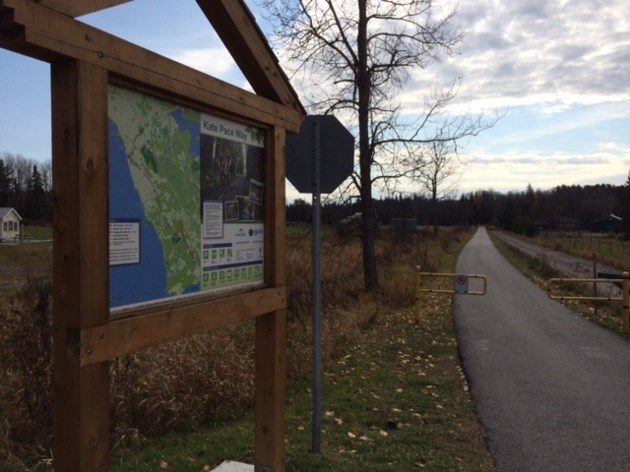Ontario Passes Bill 100 "The Supporting Ontario Trails Act"
Province Passes Act to Support Ontario's Trails
New Legislation Takes Action to Protect and Enhance Trails System
June 1, 2016 12:28 P.M.
Today, Ontario passed legislation that will sustain and improve the province's trails system, helping to build a healthier and more prosperous Ontario.
The
Supporting Ontario's Trails Act, 2016 will strengthen Ontario's extensive trails system. It will protect and enhance thousands of kilometres of the province's urban, suburban, rural and remote land and water trails while also encouraging its expansion by:
- Providing the trails community with enhanced tools to effectively develop, operate and promote trails
- Removing barriers to help connect and expand trails across the province
- Increasing trail awareness and promoting local tourism by enabling the recognition of Ontario trails of distinction, supporting communities and jobs across Ontario
- Enabling the development of a classification system to help users find trails that match their interest and ability.
The new legislation also makes amendments to existing legislation to address liability, trespassing and protection of property issues.
Protecting and improving Ontario trails is part of the government's economic plan to build Ontario up and deliver on its number-one priority to grow the economy and create jobs. The four-part plan includes investing in talent and skills, including helping more people get and create the jobs of the future by expanding access to high-quality college and university education. The plan is making the largest investment in public infrastructure in Ontario's history and investing in a low-carbon economy driven by innovative, high-growth, export-oriented businesses. The plan is also helping working Ontarians achieve a more secure retirement.
QUOTES
" Passing the supporting Ontario’s Trails Act signals Ontario’s recognition of the importance of trails and their contribution to strong, healthy and vibrant communities and local economies. This legislation will ensure Ontario’s world-class trails continue to offer a place for families, friends and future generations to explore and experience our province’s natural beauty and rich cultural heritage."
- Michael Coteau
Minister of Tourism, Culture and Sport
QUICK FACTS
- Ontario has the second-largest trails network in Canada, with about 2,500 trails spanning over 80,000 kilometres that support recreation, tourism and active transportation.
- From 2009 through 2015, the province invested approximately $130 million to support Ontario’s trails.
- Through Ontario’s 2015 Pan Am and Parapan Am Games Legacy, Ontario has supported the completion of 254 kilometres of the Trans Canada Trail Ontario resulting in a continuous route of over 2,000 kilometres, connecting communities from Ottawa to Windsor and Fort Erie to Huntsville.
- Ontario Parks protects and manages approximately 2,200 kilometres of trails and boardwalks.
- Thousands of kilometers of trails and roads are on provincial Crown land that are open for the public to use free of charge.
- In 2014, hiking expenditures by Ontarians added $559 million to Ontario’s GDP and created more than 18,000 jobs across the province with an annual economic benefit of nearly $1.4 billion.
LEARN MORE
What you should know about Bill 100 -
Purpose of Act:
The proposed Supporting Ontario’s Trails Act, 2015, if passed, would help to address a number of long-standing trail issues, including the need for a legislative mechanism to establish trail easements, clarifying liability and the standard of care required by not-for-profits and public organizations, and increasing allowable compensation for damage to property due to trespassing. It would also provide opportunities for enhanced trails tourism and the enhanced management, promotion and use of trails.
The proposed Act would enhance the Ministry of Natural Resources and Forestry’s ability to manage trails on Crown land by providing greater compliance and enforcement options, and by creating an offence for damage to Crown land and property.
Background and Elements:
The Ontario Trails Strategy was developed collaboratively by numerous provincial ministries and agencies, stakeholders and Aboriginal groups, and released in 2005. It established long-term strategic directions for planning, managing, promoting and using trails in Ontario. However, a number of long-standing issues have persisted.
In fall 2013, the Ministry of Tourism, Culture and Sport led consultations with the public, stakeholders and Aboriginal groups on ways to strengthen the Ontario Trails Strategy. This included outreach through the Environmental Bill of Rights Registry, five regional stakeholder sessions, and two Aboriginal engagement sessions. Through this process, legislative needs were identified, including a mechanism for trail easements to help secure long-term access to land for trails, amendments to the Occupiers’ Liability Act to clarify the “free entry” provision and amendments to the Trespass to Property Act to increase fines and remove the limit on compensation for damages.
The proposed Supporting Ontario’s Trails Act, 2015 (Bill 100), includes six schedules.
Schedule 1 would establish a new act entitled the Ontario Trails Act, 2015 that would:
- Proclaim an annual trails week, to coincide with International Trails Days which is held on the first Saturday in June. This could allow for the coordinated promotion of trails across Ontario.
- Allow for the recognition of Ontario trails of distinction, the establishment of a voluntary classification system and voluntary best practices and the setting of trail-related targets, to enable promotion and tourism opportunities and consistent information for trails across the province.
- Require the Minister to maintain a trails strategy that is periodically reviewed. Progress on its implementation would also be reported on.
- Set out consultative and publication requirements for the establishment of targets, a voluntary classification system, voluntary best practices, a process for recognizing Ontario trails of distinction and the review of the Ontario Trails Strategy or the current trails strategy.
- Set out a mechanism for eligible bodies, or their nominees, to enter into trail easements, with or without covenants, with willing landowners, to allow the long-term securement of land and help minimize the costly rerouting of trails.
Schedule 3 would amend the Occupiers’ Liability Act to:
- Clarify that the lower standard of care applies to occupiers of trail property which are not-for-profit or public sector organizations, even if there is an incidental fee related to access onto or use of the land, such as for parking; or if a public benefit or payment is given to a not-for-profit trail manager.
- Amend the list of lands to which the lower standard of care applies to add portages.
Schedules 2 and 4 would make complementary amendments to the Motorized Snow Vehicles Act (Schedule 2) and Off-Road Vehicles Act (Schedule 4) to:
- Align with the amendments that would be made to the Occupiers’ Liability Act.
Schedule 5 would amend the Public Lands Act to:
- Make damage to Crown land and property an offence (definition of damage to be set out in a subsequent regulation; this offence provision would have no effect until the regulation is made and approved).
- Enable a court to order a person, who has been convicted of this offence, to rehabilitate the damage.
- Provide the Ministry of Natural Resources and Forestry with new enforcement tools to stop vehicles, inspect documents, and arrest persons suspected or caught violating the Act.
- Increase the maximum penalties for offenders and the length of time to initiate charges, specifically:
- There will be different maximum penalties for individuals and corporations, and for subsequent offences. For individuals, the maximum penalties would increase from the current $10,000 to $15,000 for first offences and $25,000 for subsequent offences. For corporations, the maximum penalties would increase to $25,000 for first offences and $50,000 for subsequent offences;
- Allow the courts to, in addition to the new penalties noted above, impose an additional penalty equal to the amount of money gained by person(s) violating the Act; and
- Increase the limitation period (from the current two years from offence) to two years from discovery up to a maximum of 5 years from offence.
Schedule 6 would amend the Trespass to Property Act to:
- Raise the maximum fine from $2,000, set in 1989, to $10,000.
- Remove the limit on the amount recoverable in damages at the time of prosecution.
Schedules 1, 3 and 6 (i.e. the Ontario Trails Act, 2015 and amendments to the Occupiers’ Liability Act and Trespass to Property Act) would come into force on a day to be named by Proclamation.
Schedules 2 and 4 (i.e. the complementary amendments to the Motorized Snow Vehicles Act and Off-Road Vehicles Act) would come into force on the day amendments to the Occupiers’ Liability Act come into force.
Schedule 5 (i.e. the amendments to the Public Lands Act) would come into force on the day the Supporting Ontario’s Trails Act, 2015 receives Royal Assent.
Other Information:
This proposed Supporting Ontario’s Trails Act, 2015, if passed, would complement other trail related initiatives including the development of the Pan/Parapan Am Trails, the Waterfront Trail at Ontario Place, as well as the Ontario Cycling Strategy and first action plan.
In the coming months, the Ontario Government would also be engaging trail stakeholders on plans to further implement the Ontario Trails Strategy.
Other Public Consultation Opportunities:
If the proposed Supporting Ontario’s Trails Act, 2015 is passed, there are several elements that would require further consultation with stakeholders, other ministries, provincial agencies, the public and Aboriginal groups. Consultations would occur at a later date only if it were passed.
The Ministry of Tourism, Culture and Sport would consult on the following elements set out within Schedule 1:
- A process for recognizing Ontario trails of distinction;
- A voluntary classification system;
- Voluntary best practices;
- The periodic review of the Ontario Trails Strategy; and
- Establishing trails-related targets.
The Ministry of Natural Resources and Forestry would consult on a regulation defining damage to Crown land and property.







 Our Partnership is just the beginning! We thank you for becoming a partner, here are some of the benefits that are now yours -
Our Partnership is just the beginning! We thank you for becoming a partner, here are some of the benefits that are now yours -












